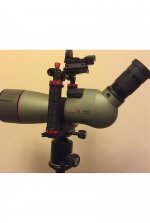-
Welcome to BirdForum, the internet's largest birding community with thousands of members from all over the world. The forums are dedicated to wild birds, birding, binoculars and equipment and all that goes with it.
Please register for an account to take part in the discussions in the forum, post your pictures in the gallery and more.
You are using an out of date browser. It may not display this or other websites correctly.
You should upgrade or use an alternative browser.
You should upgrade or use an alternative browser.
Red Dot Sights (Reflex Sights) on Spotting Scopes (2 Viewers)
- Thread starter Hauksen
- Start date
More options
Who Replied?JerryLogan
Well-known member
Very interesting design. With the red dot side mounted are you able to overcome the parallax problem at all? If so, what happens when you shift from 75 yards to 400 yards focus? Do you need to readjust every time there is a large distance differential?
Best,
Jerry
Best,
Jerry
Hi Jerry,
You might have a slight parallax problem with obstacles very close in front of the scope ... for example, I can sight through my window over my balcony rail with the reflex sight, but then find the rail blocks the view through the scope.
However, that doesn't depend on sight orientation and is a non-issue at practical observation ranges, so I think that's probably not what you meant.
The red dot sight can be adjusted in azimuth and elevation to have its sight line parallel to the optical axis of the scope, regardless of which side is up.
If you do that, the sight will point to a spot about 10 cm to the right and 5 cm above the scope's sight line, which at practical observation distances is right in the middle of the field of view.
(The field of view is about <edit:>20.7 ft at 300 yards, fully zoomed in ... an offset of 4 1/2 inches would be hard to notice, I believe.)
Regards,
Henning
Very interesting design. With the red dot side mounted are you able to overcome the parallax problem at all? If so, what happens when you shift from 75 yards to 400 yards focus? Do you need to readjust every time there is a large distance differential?
You might have a slight parallax problem with obstacles very close in front of the scope ... for example, I can sight through my window over my balcony rail with the reflex sight, but then find the rail blocks the view through the scope.
However, that doesn't depend on sight orientation and is a non-issue at practical observation ranges, so I think that's probably not what you meant.
The red dot sight can be adjusted in azimuth and elevation to have its sight line parallel to the optical axis of the scope, regardless of which side is up.
If you do that, the sight will point to a spot about 10 cm to the right and 5 cm above the scope's sight line, which at practical observation distances is right in the middle of the field of view.
(The field of view is about <edit:>20.7 ft at 300 yards, fully zoomed in ... an offset of 4 1/2 inches would be hard to notice, I believe.)
Regards,
Henning
Last edited:
Hi,
Thanks a lot!
3D printing is really great for these small but highly useful parts the original manufacturers don't provide!
Regards,
Henning
Very nice!!
Thanks a lot!
3D printing is really great for these small but highly useful parts the original manufacturers don't provide!
Regards,
Henning
JerryLogan
Well-known member
Yes, that is very interesting!!!Hi Jerry,
You might have a slight parallax problem with obstacles very close in front of the scope ... for example, I can sight through my window over my balcony rail with the reflex sight, but then find the rail blocks the view through the scope.
However, that doesn't depend on sight orientation and is a non-issue at practical observation ranges, so I think that's probably not what you meant.
The red dot sight can be adjusted in azimuth and elevation to have its sight line parallel to the optical axis of the scope, regardless of which side is up.
If you do that, the sight will point to a spot about 10 cm to the right and 5 cm above the scope's sight line, which at practical observation distances is right in the middle of the field of view.
(The field of view is about <edit:>20.7 ft at 300 yards, fully zoomed in ... an offset of 4 1/2 inches would be hard to notice, I believe.)
Regards,
Henning
My background includes rifle sighting so I’ve been more oriented toward getting the dot to the center of the view rather than parallel to the center of the view (optical axis).
Consequently, I mount the sight in front of the eyepiece on video rail which permits full alt-az adjustment. This is more accurate for a specific distance but needs readjustment when there’s a large distance differential.
I’ll give the philosophy of just getting an object into the fov a try! But I predict that astro viewing is still going to require the dot falling on the target :>)
Best,
Jerry
Last edited:
Hi Jerry,
Ah, I see! In that application, you're probably going to need a lot more accuracy than for merely pointing a scope at a bird
Astro application can use the same parallel sight-line approach, as for targets at (virtually) infinity, the parallax vanishes. (4 1/2 inches over x light years ...
In fact, I also just had an astro adapter to mount my sight on a telescope dovetail printed:
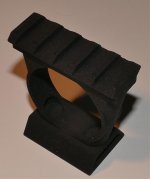
Your video-rail sight mounting sounds like an interesting solution, too. If you have any photos of that, I'd be curious to see them
Regards,
Henning
My background includes rifle sighting so I’ve been more oriented toward getting the dot to the center of the view rather than parallel to the center of the view (optical axis).
Ah, I see! In that application, you're probably going to need a lot more accuracy than for merely pointing a scope at a bird
Astro application can use the same parallel sight-line approach, as for targets at (virtually) infinity, the parallax vanishes. (4 1/2 inches over x light years ...
In fact, I also just had an astro adapter to mount my sight on a telescope dovetail printed:

Your video-rail sight mounting sounds like an interesting solution, too. If you have any photos of that, I'd be curious to see them
Regards,
Henning
JerryLogan
Well-known member
Hello Henning,
I will try to photo and post tonight. But I am also eager to see if I can overcome 30 years of putting the dot precisely on the target. I definitely qualify as an “old dog”.
Very best regards to you,
Jerry
I will try to photo and post tonight. But I am also eager to see if I can overcome 30 years of putting the dot precisely on the target. I definitely qualify as an “old dog”.
Very best regards to you,
Jerry
JerryLogan
Well-known member
Henning,
Here is a quick photo. Equipment is basically a mashup of video rig hardware. A cheese bar between two handles with sight mounted on plate. Plate (sight) moves left-right, up-down on the cheese bar. It can also be reversed to set the sight further from the eyepiece if that’s desirable.All mounted on ballhead with quick release for both just the scope and also the entire rig.
Main use is whale spotting and watching so the two handles give a very smooth, balanced motion when the ballhead tension is properly adjusted. Exclusive of the quick release hardware and sight the total cost is around $50.
If I can incorporate your “get it into the view” approach then there will be no need to readjust for the entire day - a real gift from you!
Many thanks,
Jerry
PS: Works fine with stay-on cover but took it off for more visibility in the photo.
Here is a quick photo. Equipment is basically a mashup of video rig hardware. A cheese bar between two handles with sight mounted on plate. Plate (sight) moves left-right, up-down on the cheese bar. It can also be reversed to set the sight further from the eyepiece if that’s desirable.All mounted on ballhead with quick release for both just the scope and also the entire rig.
Main use is whale spotting and watching so the two handles give a very smooth, balanced motion when the ballhead tension is properly adjusted. Exclusive of the quick release hardware and sight the total cost is around $50.
If I can incorporate your “get it into the view” approach then there will be no need to readjust for the entire day - a real gift from you!
Many thanks,
Jerry
PS: Works fine with stay-on cover but took it off for more visibility in the photo.
Attachments
Last edited:
Hi Jerry,
Thanks a lot for sharing your solution! Great use of multi-purpose components, and looks really sturdy, which I'm sure helps to keep the sight well-aligned!
Looks like the central piece is a dovetail plate with a screw-on clamp, which takes a dovetail-to-dovetail adapter, on which you have mounted the same 11-mm-dovetail sight I am using?
Regards,
Henning
Here is a quick photo. Equipment is basically a mashup of video rig hardware. A cheese bar between two handles with sight mounted on plate. Plate (sight) moves left-right, up-down on the cheese bar. It can also be reversed to set the sight further from the eyepiece if that’s desirable.All mounted on ballhead with quick release for both just the scope and also the entire rig.
Thanks a lot for sharing your solution! Great use of multi-purpose components, and looks really sturdy, which I'm sure helps to keep the sight well-aligned!
Looks like the central piece is a dovetail plate with a screw-on clamp, which takes a dovetail-to-dovetail adapter, on which you have mounted the same 11-mm-dovetail sight I am using?
Regards,
Henning
JerryLogan
Well-known member
Hi Jerry,
Thanks a lot for sharing your solution! Great use of multi-purpose components, and looks really sturdy, which I'm sure helps to keep the sight well-aligned!
Looks like the central piece is a dovetail plate with a screw-on clamp, which takes a dovetail-to-dovetail adapter, on which you have mounted the same 11-mm-dovetail sight I am using?
Regards,
Henning
Thank you Henning. It is sturdy and surprisingly light at the same time due to the video cage equipment.
The central mount is a little different than yours. The video people use NATO rails for mounting some accessories and handles. NATO rail is basically a refined picatinny or Weaver rail so most reflex sights fit natively to NATO rail without an adapter. Therefore, on my mount, there is the accessory plate that slides on the rod. Screwed to the plate is 70mm NATO rail. The sight mounts directly to the rail without adapters or dovetails.
In relation to your sight mount (which I think is terrific as is), have you considered the possibility of a simple platform with several 1/4 inch mounting holes? With that configuration the purchaser could bolt on whatever mount suits them - rail, dovetail shoe, or cold shoe (for something like the Olympus EE-1).
Or, if you’re custom 3D printing each mount and don't think the screw holes are achievable, then why not offer the choice of three possibilities and let the customer pick which at printing time?
In any case, I think you’ve got a great concept and big improvement for using the Kowa scopes.
Very best,
Jerry
Hi Jerry,
When researching the rail systems, I found a confusing variety of "NATO" rails in the video world, but couldn't quite figure out how to use them constructively. My impression was that the video community tends to use them "backwards", mounting the rails on the mobile parts and the slots on the "static" parts.
With regard to Weaver, Picatinny, NATO and "Video-NATO": My understanding is that Weaver pioneered the cross-section, but had the slots in arbitrary places. Picatinny standardized on one slot each 10 mm, and NATO merely re-defined Picatinny on a metric basis while using different faces for reference for technical reasons. (While being fully compatible to Picatinny.)
I'm not entirely sure about "Video-NATO", but according to my impression, it uses the basic cross-section, but does not require slots.
Ah, thanks for the explanation - I had the wrong mental picture of the 3D arrangement in my mind. Now I see that one can actually discern the diagonally cut-off ends of a NATO rail beneath the sight in your picture.
Sounds like a great idea! What do you have in mind with regard to seveal mounting holes? Would they be there for left/central/right mounting of the sight?
With regard to the different rail types, what I had vaguely in my mind so far was to use adapters to convert from NATO to "air gun" dovetail (which unfortunately appears to be entirely non-standardized) or cold shoe.
I'm not sure anyone would have a use for a big astro dovetail, of which there are several similar variants which I haven't really figured out yet.
With regard to screws versus different variants, single-piece mountings are obviously simpler and more sturdy, but screws might make a mounting configurable even if you stay with the same type of rail, so that idea certainly makes sense!
Thanks a lot for your great feedback! It's fascinating how many facets of a problem we can cover on this forum, and the diversity of the solutions presented in this thread definitely is inspiring!
Regards,
Henning
The video people use NATO rails for mounting some accessories and handles. NATO rail is basically a refined picatinny or Weaver rail so most reflex sights fit natively to NATO rail without an adapter.
When researching the rail systems, I found a confusing variety of "NATO" rails in the video world, but couldn't quite figure out how to use them constructively. My impression was that the video community tends to use them "backwards", mounting the rails on the mobile parts and the slots on the "static" parts.
With regard to Weaver, Picatinny, NATO and "Video-NATO": My understanding is that Weaver pioneered the cross-section, but had the slots in arbitrary places. Picatinny standardized on one slot each 10 mm, and NATO merely re-defined Picatinny on a metric basis while using different faces for reference for technical reasons. (While being fully compatible to Picatinny.)
I'm not entirely sure about "Video-NATO", but according to my impression, it uses the basic cross-section, but does not require slots.
Therefore, on my mount, there is the accessory plate that slides on the rod. Screwed to the plate is 70mm NATO rail. The sight mounts directly to the rail without adapters or dovetails.
Ah, thanks for the explanation - I had the wrong mental picture of the 3D arrangement in my mind. Now I see that one can actually discern the diagonally cut-off ends of a NATO rail beneath the sight in your picture.
In relation to your sight mount (which I think is terrific as is), have you considered the possibility of a simple platform with several 1/4 inch mounting holes? With that configuration the purchaser could bolt on whatever mount suits them - rail, dovetail shoe, or cold shoe (for something like the Olympus EE-1).
Sounds like a great idea! What do you have in mind with regard to seveal mounting holes? Would they be there for left/central/right mounting of the sight?
With regard to the different rail types, what I had vaguely in my mind so far was to use adapters to convert from NATO to "air gun" dovetail (which unfortunately appears to be entirely non-standardized) or cold shoe.
I'm not sure anyone would have a use for a big astro dovetail, of which there are several similar variants which I haven't really figured out yet.
With regard to screws versus different variants, single-piece mountings are obviously simpler and more sturdy, but screws might make a mounting configurable even if you stay with the same type of rail, so that idea certainly makes sense!
Thanks a lot for your great feedback! It's fascinating how many facets of a problem we can cover on this forum, and the diversity of the solutions presented in this thread definitely is inspiring!
Regards,
Henning
Hi again,
Here's a draft for a configurable mounting:
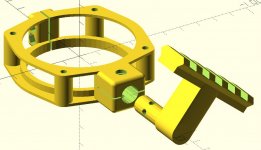
It can be switched from left to right mouting by
- removing the arm,
- losening, turning and re-tightening the ring,
- re-inserting the arm.
For the 12 o'clock mouting ("Vollmeise" style ;-), a new arm would be needed. I haven't drafted one yet, but that would be fairly straightforward.
I'd be even happier with the design if it could be made configurable to work with the TSN-884 as well as with the TSN-883, but that currently doesn't work.
(Not that I have ever heard of a birder using the TSN-884. Hm, I wonder why ...)
Regards,
Henning
With regard to screws versus different variants, single-piece mountings are obviously simpler and more sturdy, but screws might make a mounting configurable even if you stay with the same type of rail, so that idea certainly makes sense!
Here's a draft for a configurable mounting:

It can be switched from left to right mouting by
- removing the arm,
- losening, turning and re-tightening the ring,
- re-inserting the arm.
For the 12 o'clock mouting ("Vollmeise" style ;-), a new arm would be needed. I haven't drafted one yet, but that would be fairly straightforward.
I'd be even happier with the design if it could be made configurable to work with the TSN-884 as well as with the TSN-883, but that currently doesn't work.
(Not that I have ever heard of a birder using the TSN-884. Hm, I wonder why ...)
Regards,
Henning
Hi Phil,
Here's a draft of a version with a quick release, bicycle style.
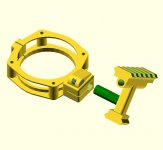
It's still a bit bulky because the cross dowel is a metal part, and I couldn't find one of less than 12 mm length.
Still, the nice thing is that the mounting arm, once remoeved, is more compact than the "snap around" version could be.
Regards,
Henning
I'm not sure how practical this would be, or even which material would be most suitable but the thought of a "snap on" sight mount is quite appealing.
Here's a draft of a version with a quick release, bicycle style.

It's still a bit bulky because the cross dowel is a metal part, and I couldn't find one of less than 12 mm length.
Still, the nice thing is that the mounting arm, once remoeved, is more compact than the "snap around" version could be.
Regards,
Henning
Super Dave
Well-known member
Wow. You guys are amazing!!! Love it.
Torchepot
Well-known member

Hi Henning
Thanks for your latest draft - I wish I had access to some graphics software - but I'm travelling at the moment so writing on a tablet.
Your drawings are so much easier to understand than a description of the same thing!
What I had in mind is rather similar to your design (but with one eye on simplicity, cost and ease of manufacture) I was thinking of replacing the machined "cage" which goes around the eyepiece with a reusable cable tie.
This has the advantage of "one size fits all" and very low cost to replace.
Cheers
Phil
Thanks for your latest draft - I wish I had access to some graphics software - but I'm travelling at the moment so writing on a tablet.
Your drawings are so much easier to understand than a description of the same thing!
What I had in mind is rather similar to your design (but with one eye on simplicity, cost and ease of manufacture) I was thinking of replacing the machined "cage" which goes around the eyepiece with a reusable cable tie.
This has the advantage of "one size fits all" and very low cost to replace.
Cheers
Phil
Hi Phil,
That would probably have worked great for my first variant that attached around the objective cylinder!
For the attachment ring, a cable tie would not exclusively be stressed in "pull" direction, but it would also have to carry a bending moment, since the attachment block doen't have a corresponding surface on the scope to be pulled against. Basically, it's only supported on its lower edge.
That's why I think I need a big and stiff vertical ring. It's not actually an machined artifact, but rather a 3D printed plastic part, so the price is not going to be so bad. The entire assembly is going to be less expensive than my original objective clamp with the "tower".
"One size fits all" would of course be a great accomplishment, but I think the method of attachment is really limited to scopes with a Kowa-style accessory thread, and I guess only the Kowa TSN-883/4 have this. (I haven't actually checked other Kowa scopes ... on pictures, it's hard to see since it's hidden by a smooth fairing ring. I'd probably have to download and read the manuals.)
The attachment block itself has a 9-sided polygonal mount, which works great for the 40 degree angle of the TSN-883, but wouldn't work for a 45 degree angled scope, which I think is more common, or even for the straight TSN-884. (If the angle had been 45 degrees, I could just have used an octagonal mount that would have been good for straight and angled scopes alike.)
However, not to say that the cable tie idea wouldn't work well with other scopes. If you have an eyepiece with a fixed cylinder, that would probably work just fine with a cable tie (or two) on any scope. (With the zoom eyepiece on the Kowa, the entire eyepiece cylinder rotates when zooming.)
If you have an eyepiece cylinder like that, you could post the dimensions here, and I'll see if I can come up with a simplified version of the attachment ring.
I guess all it would need would be two slots on the backside to run two cable ties through (or one big one), and maybe the backside should also be curved to better conform with the eyepiece contour.
Regards,
Henning
What I had in mind is rather similar to your design (but with one eye on simplicity, cost and ease of manufacture) I was thinking of replacing the machined "cage" which goes around the eyepiece with a reusable cable tie.
That would probably have worked great for my first variant that attached around the objective cylinder!
For the attachment ring, a cable tie would not exclusively be stressed in "pull" direction, but it would also have to carry a bending moment, since the attachment block doen't have a corresponding surface on the scope to be pulled against. Basically, it's only supported on its lower edge.
That's why I think I need a big and stiff vertical ring. It's not actually an machined artifact, but rather a 3D printed plastic part, so the price is not going to be so bad. The entire assembly is going to be less expensive than my original objective clamp with the "tower".
"One size fits all" would of course be a great accomplishment, but I think the method of attachment is really limited to scopes with a Kowa-style accessory thread, and I guess only the Kowa TSN-883/4 have this. (I haven't actually checked other Kowa scopes ... on pictures, it's hard to see since it's hidden by a smooth fairing ring. I'd probably have to download and read the manuals.)
The attachment block itself has a 9-sided polygonal mount, which works great for the 40 degree angle of the TSN-883, but wouldn't work for a 45 degree angled scope, which I think is more common, or even for the straight TSN-884. (If the angle had been 45 degrees, I could just have used an octagonal mount that would have been good for straight and angled scopes alike.)
However, not to say that the cable tie idea wouldn't work well with other scopes. If you have an eyepiece with a fixed cylinder, that would probably work just fine with a cable tie (or two) on any scope. (With the zoom eyepiece on the Kowa, the entire eyepiece cylinder rotates when zooming.)
If you have an eyepiece cylinder like that, you could post the dimensions here, and I'll see if I can come up with a simplified version of the attachment ring.
I guess all it would need would be two slots on the backside to run two cable ties through (or one big one), and maybe the backside should also be curved to better conform with the eyepiece contour.
Regards,
Henning
Torchepot
Well-known member

Hi Henning
Yes of course you are right - I keep forgetting that almost all of the Kowa zoom barrel rotates! The kind of design I'm thinking of which is pretty much exactly as you just described would be suitable for eyepieces like the Nikon 38x wide fixed mag which I use on my scope or anything similar.
The base part could be cable tied around the eyepiece and then the sight mount just clipped on or quick released as necessary.
I wonder how many popular scope eyepieces actually have enough clear barrel to make such an attachment feasible?
Cheers
Phil
Yes of course you are right - I keep forgetting that almost all of the Kowa zoom barrel rotates! The kind of design I'm thinking of which is pretty much exactly as you just described would be suitable for eyepieces like the Nikon 38x wide fixed mag which I use on my scope or anything similar.
The base part could be cable tied around the eyepiece and then the sight mount just clipped on or quick released as necessary.
I wonder how many popular scope eyepieces actually have enough clear barrel to make such an attachment feasible?
Cheers
Phil
Hi Phil,
Here's a new draft:
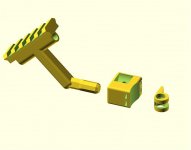
The cut-outs for the cable tie are 6 x 2 mm^2. The height of the attachment block is 18 mm. The inner diameter the attachment block is supposed to match is 54.2 mm, but thanks to the flexibility of cable ties, the exact measurement probably doesn't matter much. It's set up for 45 degrees angle ... not sure what Nikon actually uses.
I've created a "12 o'clock" attachment arm to go with it.
The three parts print for, depending on options, less than 30 EUR at shapeways.com. Additional parts required screw 1 DIN 84 M4 x 20 mm, 1 cross dowel 12 mm x 6 mm M4. And of course 2 cable ties
(Thinking about a second eccentric lever to increase cable tie tension after they're closed, to ensure "no slip" fit to preserve aimpoint. Probably not worth it unless this version loses aimpoint too easily.)
Regards,
Henning
The kind of design I'm thinking of which is pretty much exactly as you just described would be suitable for eyepieces like the Nikon 38x wide fixed mag which I use on my scope or anything similar.
The base part could be cable tied around the eyepiece and then the sight mount just clipped on or quick released as necessary.
Here's a new draft:

The cut-outs for the cable tie are 6 x 2 mm^2. The height of the attachment block is 18 mm. The inner diameter the attachment block is supposed to match is 54.2 mm, but thanks to the flexibility of cable ties, the exact measurement probably doesn't matter much. It's set up for 45 degrees angle ... not sure what Nikon actually uses.
I've created a "12 o'clock" attachment arm to go with it.
The three parts print for, depending on options, less than 30 EUR at shapeways.com. Additional parts required screw 1 DIN 84 M4 x 20 mm, 1 cross dowel 12 mm x 6 mm M4. And of course 2 cable ties
(Thinking about a second eccentric lever to increase cable tie tension after they're closed, to ensure "no slip" fit to preserve aimpoint. Probably not worth it unless this version loses aimpoint too easily.)
Regards,
Henning
Torchepot
Well-known member

Very nice work Henning - if they were available I'd buy one - I've always been curious about the red dot sights and with such a small, discreet block attached to the scope it would be easy to leave it in place whilst transporting it and simple to quickly attach the sight when needed.
:t:
Phil
:t:
Phil
Hi Phil,
If you're interested, I'll provide the print file for free ... just upload it to shapeways.com (or your 3D print provider of choice) and have it printed. (Or print it at home, if you have a 3D printer
It's too big for uploading it here ... 14 MB - I hope your inbox can take that.
I've slightly tidied up the arm with the rail:
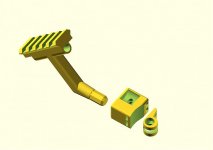
Just be aware that the adapter is entirely untested, and I haven't cross-checked the dimensions of your scope. Measure thrice, print once, etc. ;-) You'll be your own alpha tester if you have this printed.
I presume you prefer the version with the arm for mounting at 12 o'clock - otherwise, let me know and I'll provide the side-mounting version. The attachment block itself works with 3/9/12 o'clock mounting anyway.
Regards,
Henning
Very nice work Henning - if they were available I'd buy one - I've always been curious about the red dot sights and with such a small, discreet block attached to the scope it would be easy to leave it in place whilst transporting it and simple to quickly attach the sight when needed.
If you're interested, I'll provide the print file for free ... just upload it to shapeways.com (or your 3D print provider of choice) and have it printed. (Or print it at home, if you have a 3D printer
It's too big for uploading it here ... 14 MB - I hope your inbox can take that.
I've slightly tidied up the arm with the rail:

Just be aware that the adapter is entirely untested, and I haven't cross-checked the dimensions of your scope. Measure thrice, print once, etc. ;-) You'll be your own alpha tester if you have this printed.
I presume you prefer the version with the arm for mounting at 12 o'clock - otherwise, let me know and I'll provide the side-mounting version. The attachment block itself works with 3/9/12 o'clock mounting anyway.
Regards,
Henning
Users who are viewing this thread
Total: 3 (members: 0, guests: 3)





